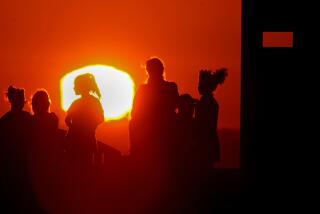Study predicts more hot spells in Southern California
- Share via
By the middle of the century, the number of days with temperatures above 95 degrees each year will triple in downtown Los Angeles, quadruple in portions of the San Fernando Valley and even jump five-fold in a portion of the High Desert in L.A. County, according to a new UCLA climate change study.
The study, released Thursday, is the first to model the Southland’s complex geography of meandering coastlines, mountain ranges and dense urban centers in high enough resolution to predict temperatures down to the level of micro climate zones, each measuring 2 1/4 square miles. The projections are for 2041 to 2060.
Not only will the number of hot days increase, but the study found that the hottest of those days will break records, said Alex Hall, lead researcher on the study by UCLA’s Institute of the Environment and Sustainability. The record for downtown Los Angeles is 113 degrees, set Sept. 27, 2010, when the Department of Water and Power electricity demand reached a historic peak of 6,177 megawatts.
Mayor Antonio Villaraigosa said the forecasts provide the groundwork for local governments, utilities, hospitals and other institutions to prepare for the hot spells to come. Villaraigosa said the region may have to strengthen building codes to reduce risk to residents. “That could mean replacing incentives with building codes requiring ‘green’ and ‘cool’ roofs, cool pavements, tree canopies and parks,” he said.
The study, aided by a UCLA supercomputer, is 2,500 times more precise than previous climate models for the region, said Paul Bunje, executive director of the UCLA Center for Climate Change Solutions. The computer made roughly 1 quintillion calculations — the equivalent of eight times all the grains of sand on the beaches of the western United States — over a period of six months to assess every aspect of 25 global warming models that might be applicable to Southern California.
The computer found, for example, that the number of days exceeding 95 degrees a year is likely to increase from eight to 30 in Porter Ranch, 55 to 91 in Bakersfield and from 75 to 119 in Palm Springs. In the L.A. County High Desert community of Palmdale, temperatures will rise above 95 degrees 33 days a year, up from seven currently, according to the analysis.
Los Angeles, fanned by ocean breezes, will see 95-and-over days increase a relatively modest three-fold from the current 1 1/2 per year. The Santa Monica Mountains are enough of a barrier to cooler ocean influences that the San Fernando Valley will warm 10% to 20% more than the L.A. Basin.
More generally, the research showed that oceans and coasts are likely to warm by 2 to 3 degrees, dense urban areas by 4 degrees, and mountains and deserts by 4 to 5 degrees.
The highest elevations of the San Gabriel and San Bernardino Mountain ranges could see temperatures soar by as much as 7 degrees on average, Hall said. The higher temperatures will arise from less snowfall in winter and more snowmelt in spring, he said. The result will be a decrease in snow cover, leading to more surface absorption of solar radiation, and hence more warming.
The study, commissioned by the City of Los Angeles and paid for with $500,000 in U.S. Energy Department funds, assumed “business as usual” worldwide in greenhouse gas emissions. But researchers said the hotter temperatures will come even if emissions are reduced because the Earth would need many decades to adjust.
UCLA researchers noted that today’s 35-year-olds will be elderly by mid-century and among the population segments most vulnerable to extreme heat, along with children and people with chronic health problems.
“There will definitely be health impacts felt with that kind of a climate shift,” said Richard Jackson, chair of Environmental Health Sciences at UCLA. “We should expect to see more allergies, mosquito vectors and air pollution from wildfires.”
The study raises concerns, said Los Angeles Department of Water and Power Commissioner Jonathan Parfrey, about the long-term sustainability of Los Angeles’ water supplies, which are replenished by snow and water captured by local mountain chains.
“Higher future temperatures could reduce the snowpack and thus affect our water systems,” Parfrey said. “On the electricity front, the hotter it gets, the more electricity we use to keep our houses cool and the milk chilled. Yet, higher temperatures will cause our power plants to run less efficiently.”
“This much is clear: The City of Los Angeles is at a crossroads,” he added. “We have time to limit the severity of climate impacts. By smart planning, we can adapt to changes and continue to prosper.”







